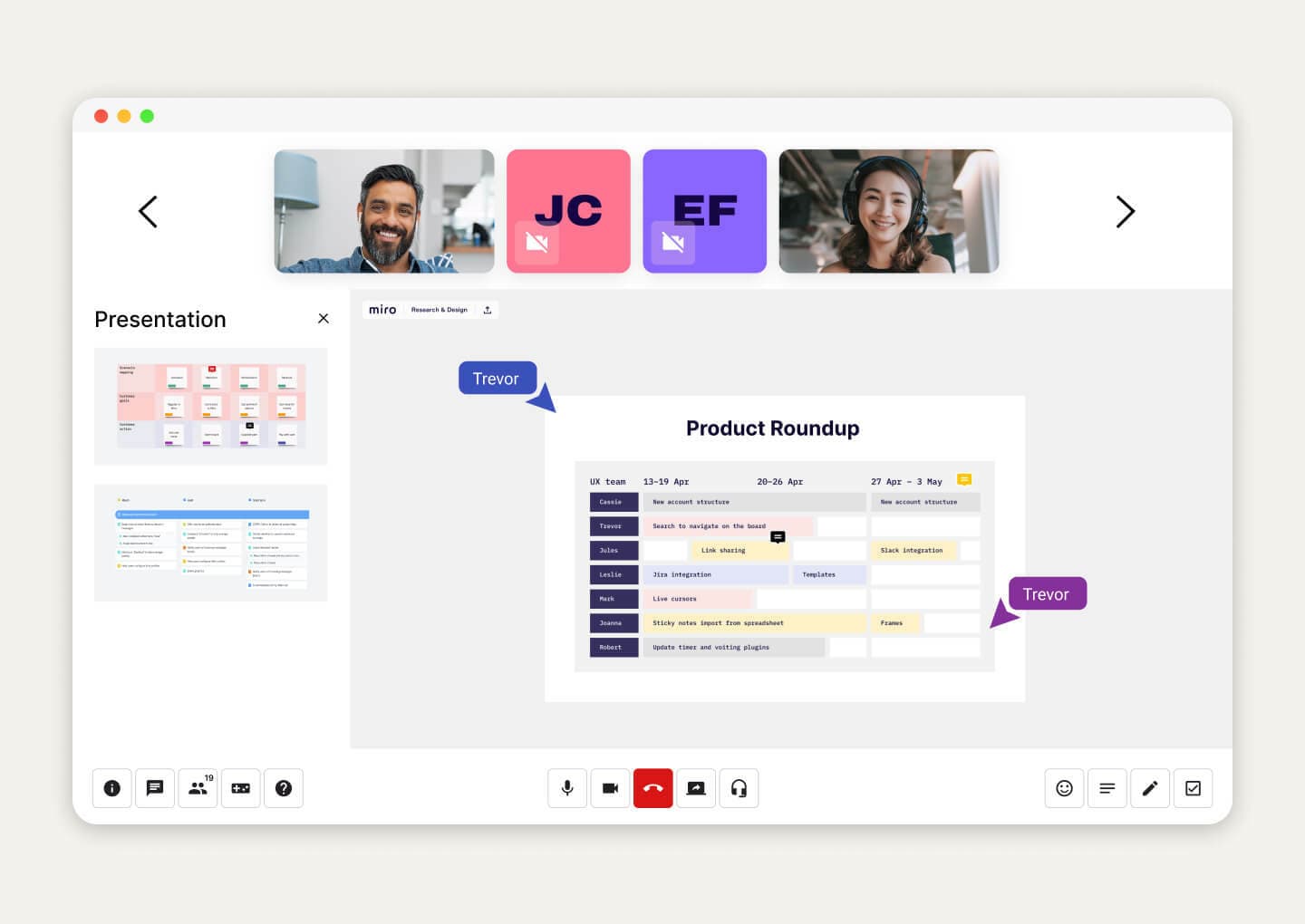How to create a balanced hybrid work schedule

Senior Content Marketing Manager

Tags
Share
Hybrid work has become increasingly popular in recent years—and for good reason—as it offers a great deal of flexibility and can be tailored to fit the needs of specific teams and employees.
But creating a balanced hybrid work schedule that truly empowers your team can be tricky, as there’s a few things to consider.
In this blog post, we'll explore some of the different types of hybrid work schedules, as well as some tips for creating a schedule that works for you and your team.
What is a hybrid work schedule?
A hybrid work schedule is a schedule that allows employees to work both remotely and in the office. Some companies may have a hybrid work schedule where two days of the week are spent in the office and three days remote, while others may have a schedule that's four days in the office and Thursdays remote.
A hybrid work schedule can help employees have a better work-life balance. It can also help teams work together and communicate more effectively. The important thing to remember is that a hybrid schedule is a flexible work schedule that can be customized to the needs of the company and the employees.
Creating a hybrid schedule that’s the right fit for your team, however, is all about finding what works best for both real-time and asynchronous work.
The different types of hybrid work schedules
1. Cohort schedule
A cohort schedule is like working different shifts at the office. You would group employees by department, team, workload, or task. Then each group has a different in-office work schedule.
Might work for you if: Your teams need close collaboration. By combining the necessary people and departments into a single group, you can schedule on-premises meetings more regularly and support your teams' in-person collaboration needs.
2. Staggered schedule
This is similar to the cohort model with one key difference: team members come to the office at set times throughout the work day. The purpose of a staggered schedule is to prevent overcrowding at the office. This one will definitely need a bit more work though, since you'll need to understand which shifts work best for which teams.
Might work for you if: You reduced your office space during the pandemic or leased a coworking space, and are concerned about overcrowding.
3. Remote-first schedule
A remote-first schedule prioritizes remote work without totally letting go of office time either. In other words, remote work is given priority, but employees still have the option to come into the office if they'd like.
Might work for you if: If the feedback from your team was the majority of them prefer to work remotely, and you have the tools necessary to go fully remote.
4. Office-first schedule
An office-first hybrid work schedule prioritizes—you guessed it—working in the physical office. However, your company still offers some remote days or remote work options as well, but maybe only for specific teams (e.g. dev teams can work at home while customer-facing teams need to be at the office) or under certain circumstances (e.g. childcare or something else in their personal life).
Might work for you if: The type of work your teams do is best done in person but your employees still want some remote options, or you don't have the infrastructure in place to offer remote work (yet).
5. Pick-your-own
This hybrid work schedule is all about giving your employees the autonomy to choose their own office schedule (or not). This is my personal favorite, because it offers the most flexibility. And apparently I’m not alone in wanting that—research has shown that 75% of workers want to retain a flexible schedule after the pandemic.¹
Some prefer to work onsite because they're able to connect with their coworkers in person, prefer the physical separation between home and their workspace, or because there's better Wi-Fi there. Some people prefer to work offsite because they're able to be more productive, to have time back from commuting, or simply because it's more comfortable. And others prefer a combination of both. A flexible schedule like this one gives them the freedom to choose where they want to work on any given day.
Might work for you if: You work at a digital-first organization that doesn't necessarily need team members to be in the same physical office space to get things done effectively.
How to create a balanced hybrid work schedule (in 5 steps)
Assuming your company is on board with the idea of a hybrid work environment, there are a few things to keep in mind as you create a hybrid work schedule that works for your team.
Step 1: Ask your team what they want in a hybrid work schedule
Like with any major business change, the first thing you should do when transitioning to a new hybrid work schedule is talk to your employees. The goal is to understand what most of the people at your company want in a hybrid workplace. Involving your team in the decision-making process will help you define your hybrid work schedule moving forward.
Depending on the size of your organization, this could be as simple as having a few 1-on-1s to sending out a company-wide survey to gather everyone's feedback. You could also create a "workplace planning team" that includes representatives from all the different departments across the organization to voice the sentiment of their respective departments.
For example, here at Dialpad, we have some teammates working in-office and some working remotely full-time—and we use Dialpad's communications platform to message and have video calls with each other:

Some questions you could ask are:
Post-pandemic, what's your ideal work situation?
How many days would you like to work in the office?
Do you prefer to work in the office on certain days?
How do you prefer to collaborate with others?
Should certain team meetings be held in person?
Step 2: Define what gets done in and out of the office
One of the first things to do when developing a hybrid work schedule is to decide what work will be done in and out of the office.
Like meetings—will you have them in or out of the office? With the right video conferencing setup, you can easily incorporate a hybrid model that works for all of your employees' work arrangements.
And what about group project meetings? Do teams need to physically gather in the same space to complete a project? If they only need to meet sometimes, define how often that is, and tailor it to each department.
If you're in an industry where you need to review visual projects, like advertising or architecture, make sure you have software that allows you to do screen sharing. For example, Dialpad not only has built-in video conferencing and screen sharing, but also integrates with Miro, a whiteboarding app that makes it feel like you're literally in a room with your teammates:

Defining what gets done in the office and outside will give your employees easy guidelines to follow for the new hybrid work model. This will streamline the transition and allow employees to make the best choices for themselves.
Step 3: Ensure there's collaboration equity for both in-office and remote teams
Picture this: You have ten participants about to join a meeting—five are in the conference room in the office, and five are dialing in from their homes.
How can you make sure that this arrangement doesn't affect teamwork and communication?
This is where a concept called "collaboration equity" comes into play.
Collaboration equity refers to the ability for everyone on a team, regardless of where they're located, to access the same resources and work together effectively to do their jobs. If everyone can do that in an equally effective way, then you've got collaboration equity. But if it's much harder for remote workers at home to, say, brainstorm with their teammates who are all in a conference room in the office because the company isn't using virtual meeting software, then you don't have collaboration equity.
Step 4: Clearly communicate your hybrid work schedule
A McKinsey report² found that a lack of communication surrounding hybrid work policies causes feelings of anxiety among both in-office and remote employees. In a time where there's so much uncertainty already, people just want to know what's expected of them, when, and where.
Communicate changes in workplace strategy regularly. If there's not much to report, talk to your team and open the floor for questions. Let them know about their workplace safety options.
DIALPAD TIP:
If you have multiple communication channels, like both email and chat, it's a good idea to define what each channel is for so employees aren't confused. For example, email can be used for team-wide updates and announcements, whereas team messaging can be used to communicate information to smaller groups or individuals.
Just remember that there's no such thing as overcommunication, and your team members will appreciate the transparency.
Step 5: Gather employee feedback and use it to make improvements to your hybrid work schedule as needed
If you find that the schedule isn't working for your team, don't be afraid to make changes. The goal is to find a schedule that works for everyone while also helping your company achieve its objectives.
To find the best hybrid work schedule for your organization, you need to continuously receive feedback from your team about what's working and what's not. Regular chats, one-on-one sessions, listening tours, facetime, and ask-me-anything sessions can bolster employee and leadership relationships.
You could send out regular employee feedback surveys to gauge how hybrid work is progressing. Or, use a specific channel for employee feedback on a messaging platform like Dialpad or Slack.
Some examples of questions you could ask are:
What do you enjoy most about working from home?
What's been your biggest challenge working from home?
What do you look forward to most when going to the office?
What do you look forward to the least?
Has your productivity increased, decreased, or stayed the same while working at home?
Has your ability to collaborate with your team increased, decreased, or stayed the same while working at home?
What types of events have worked well to keep remote employees engaged and our company culture alive when they're dispersed or in the office?
Do you feel there are enough hybrid team-building experiences?
Use the answers to these questions to understand what your team members want and continually improve your hybrid work schedule
Create a hybrid work schedule everyone loves
Creating a hybrid work schedule can be a challenge, but it's worth it to find a balance that works for you and your team. With a little planning and flexibility, you can create a schedule that everyone can be happy with.
Dialpad powers hybrid teams like yours
See how Dialpad's unified communications platform can help your business successfully move to hybrid work! Book a product demo to check it out or, take a self-guided interactive tour of the app on your own first!








